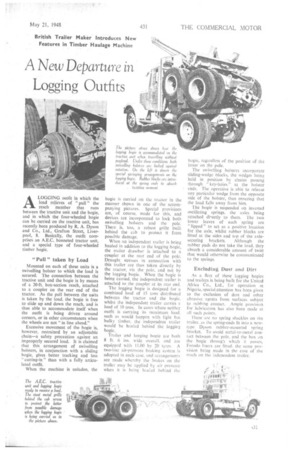A New Departure in
Page 33

If you've noticed an error in this article please click here to report it so we can fix it.
Logging Outfits
ALOGGING outfit in which the load relieves of "pull" the reach member that runs between the tractive unit and the bogie, and in which the four-wheeled bogie can be carried on the tractive unit, has recently been produced by R. A. Dyson and Co., Ltd., Grafton Street, Liverpool, 8. Basically, the outfit comprises an A.E.C. bonneted tractor unit, and a special type of four-wheeled timber bogie.
"Pull" taken by Load Mounted on each of these units is a swivelling bolster to which the load is secured. The connection between the tractive unit and the bogie is by means of a 20-ft. box-section reach, attached to a coupler on the rear end of the tractor. As the pull between the waits is taken by the load, the bogie is free to slide up and down the reach, and is thus able to accommodate itself when the outfit is being driven around corners, or in other circumstances when the wheels are not "in line ahead."
Excessive movement of the bogie is, however, restrained by an adjustable chain—a safety precaution against an improperly secured load. It is claimed that this arrangement of swivelling bolsters, in conjunction with a sliding bogie, gives better tracking and less "cutting-in" than with a fully articulated outfit.
When the machine is unladen, the bogie is carried on the tractor in the manner shown in one of the accompanying pictures. Special provisions are, of course, made for this, and devices are incorporated to lock both swivelling holsters and the pole. There is, too, a robust grille built behind the cab to protect it from possible damage.
When an independent trailer is being hauled in addition to the logging bogie, the trailer drawbar is 'attached to a coupler at the rear end of the pole. Draught stresses in connection with this trailer are thus taken directly by the tractor, via the pole. and not by the logging bogie. When the bogie is being carried, the independent trailer is attached to the coupler at its rear end.
The logging bogie is designed for a combined load of IS tons distributed between the tractor and the bogie, whilst the independent trailer carries a load of 10 tons. In cases where neither outfit is carrying its maximum load, such as would happen with light but bulky timber, the independent trailer would be hauled behind the logging bogie.
Trailer and logging bogie are both 8 ft. 6 ins, wide overall, and are equipped with 11.00 by 20 tyres. A two-line air-pressure braking system is adopted in each case, and arrangements are made whereby the brakes on the trailer [nay be applied by air pressure when it is being hauled behind the bogie, regardless of the position of the latter on the pole.
The swivelling bolsters incorporate sliding-wedge blocks, the wedges being held in position by chain S passing through " key-holes" at the holster ends. The operative is able to release any particular wedge from the opposite side of the bolster, thus ensuring that the load falls away from him.
The bogie is suspended on inverted oscillating springs, the axles being attached directly to them. The two lower leaves of each spring are " lipped " to act as a positive location for the axle, whilst rubber blocks are fitted at the sides and top of the axlesecuring brackets. Although the rubber pads do not take the load, they absorb a considerable amount of twist that would otherwise be communicated to the springs.
Excluding Dust and Dirt
As a fleet of these logging bogies and trailers is being built for the United Africa Co., Ltd., for operation in Nigeria, special attention has been given to the exclusion of dust and other abrasive agents from surfaces subject to rubbing contact. Ample provision for lubrication has also been made at all such points.
There arc no spring shackles on the trailer, as the spring-ends fit into .a newtype Dyson rubber-mounted spring bracket. To avoid metal-to-metal contact between the pole, and the box on the bogie throug!1 which it passes, Fermi° liners are fitted. the same provision being made in the case of the reach on the independent trailer.












































































